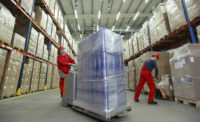For any startup enterprise, the goal is to hit the ground running and succeed beyond all expectations.
Such is the case with Wanniassa Wheeler Food, an Australian food processor that four years ago planned to make dramatic changes to its business strategy—shift from being a low-volume supplier for a local franchise food chain to becoming a high-volume food processor providing a variety of culinary and convenience foods to global wholesalers, retailers and other food processors.
This would be a tall order for most companies, but Wanniassa Wheeler had a vision that reconfiguring its 60,000-square-foot facility with the proper equipment would enable the creation of a diversified line of cooked protein products while still continuing to supply its 47-store chain of Ali Baba quick-service restaurants.
The chief idea for the new strategy was to cook proteins such as chicken, lamb, beef and turkey in the high volumes needed to satisfy supermarkets and even big box outlets such as Costco while also offering quality ranging from restaurant to gourmet level.
“Our experience in cooking various meat products was limited to combination and walk-in ovens, but we knew those would not satisfy our requirement to have a high-care facility,” says Ali Marjan, manager of strategic and business development for Wanniassa Wheeler. “We wanted to minimize product contamination and restrict human handling of products to only placing them on a belt at the front end of the oven. After cooking, the product would automatically be transported to a chilling system and either shipped or stored.”
According to Marjan, some type of conveyor oven would be the solution. That’s when Barry Hansell, sales manager at Reactive Engineering, an Australian supplier of processing and packaging equipment, recommended the spiral oven.
Spiraling to success
The spiral oven, which offers a minimal footprint, increased yield and product consistency, has been adopted as the continuous cooking system of choice among many ready-to-eat frozen and chilled food processors. It allows them the versatility to roast, steam, bake, broil or even pasteurize ready-meals in a single piece of equipment. Examples range from baked quiches, meatballs and chicken wings, to oven-roasted vegetables and steamed chicken breast.
Spiral ovens are available in a variety of sizes, but Wanniassa Wheeler wanted smaller-sized equipment still capable of producing higher volumes and easy to operate while cooking a variety of products.
That’s why Wanniassa Wheeler selected the Micro Spiral Oven, developed by Unitherm Food Systems, Bristow, Okla., because of its self-basting capability.
“As you are cooking, particularly when we get into some higher volumes, the self-basting capabilities of this spiral oven help to improve yields,” says Marjan. “Because the products travel upward on the belt from the bottom of the spiral oven, as the products cook through the juices that result from the cooking start basting downward onto the products below. The result is some additional yield, but the more important difference is that you are adding a lot of flavor, which is definitely a winner.”
At that point, adding a Unitherm Mini Spiral Oven was the right solution. With overall dimensions of 8' wide x 12' long x 13' tall, the Mini Spiral Oven increased Wanniassa Wheeler’s cooking capacity to approximately 1,500 pounds per hour, but addressed the growing demand for alternate uses, including the ability to provide customers with an in-house test cooking facility. In addition to protein products, Wanniassa Wheeler is now roasting vegetables such as eggplant, peppers, potatoes and items that are put into Ali Baba dips in its Micro Spiral Oven.
In-cook food safety
Another important benefit of the spiral oven is food safety provided by “in-cook” pasteurization.
“Since we are a straight cook-chill business, one of the important features of our spiral oven we selected is the ‘high-steam’ process,” says Marjan. “If you compare the spiral oven from Unitherm with a combi oven (combination convention oven and steamer) that has the same functions, they normally remain at 212°F. With our Micro Spiral Oven and Mini Spiral Oven, the steam goes up to 266°F. A steam separation system allows this high steam to contact products at the beginning of the process, and then they go through a slow process, perhaps another 2-3 minutes, depending on the product. This process results in what I call an ‘in-cook pasteurization process’ that kills pathogens that could survive in a typical cook-chill process. So, as long as we chill the product quickly enough, we are able to maintain that high level of food safety.”
Opening sales channels
Marjan says that installation of the micro spiral got Wanniassa Wheeler up to speed quickly, and resulted in its successful entry into the retail segment. Shortly afterward, the company began to receive inquiries for authentic flame-grilled products.
“Our traditional products were sliced protein products, so having a flame grill allowed us to work with even more meat goods, such as quarter pound breast fillets that are flame grilled, and the same with beefsteak products and lamb products that are marked. So, the flame grill gives you color, and it also caramelizes to a certain degree. In the end, the appearance was the biggest benefit.”
Because Unitherm’s Micro Spiral Oven was able to connect directly to the flame grill, the production line could be easily expanded. This combination of Micro Spiral Oven and flame grill was responsible for opening up new sales channels for Wanniassa Wheeler. For example, some of the supermarkets started to work with the company to develop a line of flame-grilled chicken tenders, breasts and wings. Wanniassa Wheeler was also able to enter the burger patty market for the first time. One of its new products is a high-end line of wagyu beef burger patties.
The two spiral ovens were in large part responsible for Wanniassa Wheeler’s rapid growth. Not only did this equipment enable the company to exceed its goals quickly, but it also facilitated the addition of the flame grill in an in-line configuration, which allowed it to rapidly expand into additional products and markets. Further, these additional capital investments were implemented without going through the efforts to research and test equipment from another vendor, thereby getting to market faster and more efficiently.



